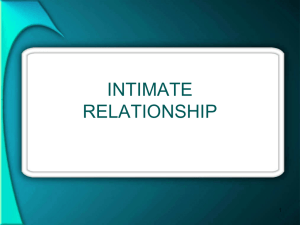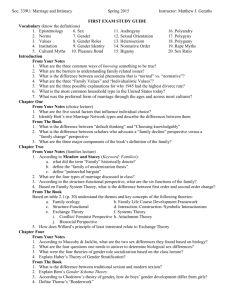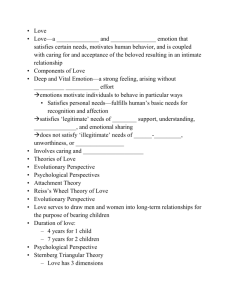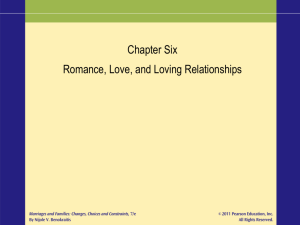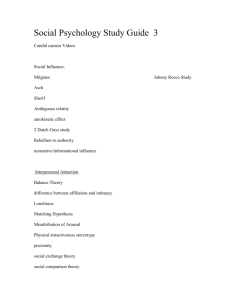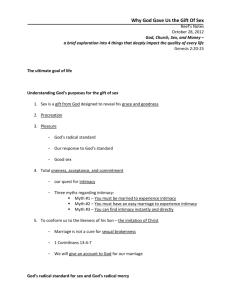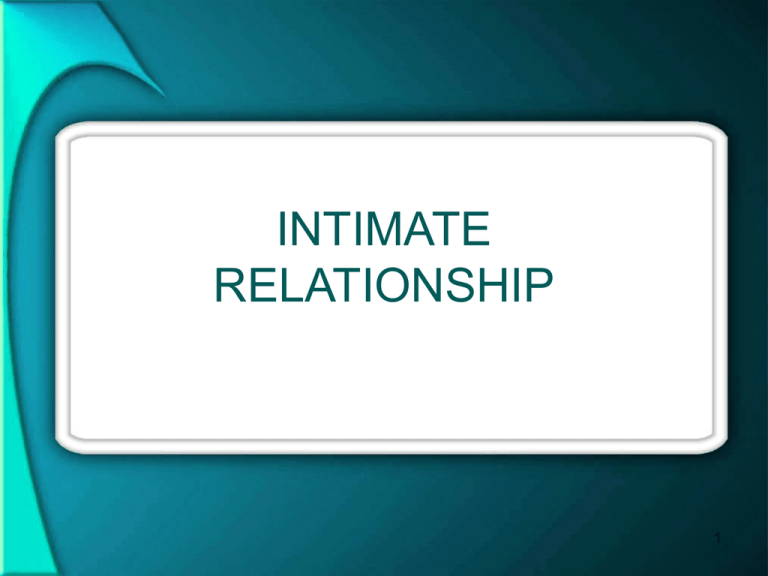
INTIMATE
RELATIONSHIP
1
INTIMACY
• Intimacy refers to sharing that
which is inmost with others.
• The word itself is derived from the
Latin intimus, which means
“inner” on “inmost”
2
PARENT-CHILD
ATTACHMENT
3
What is attachment
• Attachment refers to the strong
emotional bond between an infant
and a caregiver
4
• Parent-child attachment patterns
influence later childhood peer
relations and intimate adult
relationship
5
• People with a secure
attachment style have more
successful intimate
relationships later in life than
those who are insecurely
attached
6
ATTACHMENT STYLE
•
•
•
•
Secure Attachment Style
Preoccupied Attachment Style
Dismissing-Avoidant Attachment Style
Fearful-Avoidant Attachment Style
7
Secure Attachment Style
• Attachments marked by trust that
the other person will continue to
provide love and support
8
Preoccupied Attachment Style
• An expectation about social
relationships characterized by trust
but combined with a feeling of being
unworthy of others love and fear of
abandonment
9
Dismissing-avoidant
Attachment Style
• An expectation about social
relationships characterized by low
trust and avoidance of intimacy,
combined with high self-esteem and
compulsive self-reliance
10
Fearful-Avoidant
Attachment Style
• An expectation about social
relationships characterized by low trust
and avoidance of intimacy, combined
with a feeling of being unworthy of
other’s love and a fear of rejection
11
FRIENDSHIP
12
Friendship
• As we mature, we not only form
emotional ties with our family
members, we also form friendship
outside the home.
13
Friendship
• Relationships based on friendship
are primarily voluntary and
mutually satisfying
14
SELF-DISCLOSER SHAPES FRIENDSHIP
DEVELOPMENT AND MAINTENANCE
• Self-disclosure
–The revealing of personal
information about oneself to other
people
15
SELF-DISCLOSER SHAPES FRIENDSHIP
DEVELOPMENT AND MAINTENANCE
• Social Penetration Theory
–A theory that describe the
development of close relationship
in terms of increasing selfdisclosure
16
GENDER DIFFERENCES EXIST IN
HETEROSEXSUAL FRIEDSHIP
• Intimacy
–Women’s friendships tend to be
more intimate and involve more
emotional sharing than men’s
relationship
17
GENDER DIFFERENCES EXIST IN
HETEROSEXSUAL FRIEDSHIP
• Self-Disclosure
– Women generally self-disclose more than
men, especially in intimate relationship
• Physical Touching
– Male friends less touching than did either
female friends or mixed-sex friends
18
Cross-Sex Heterosexual Friendships
Gravitate to an “Intimacy Mean”
• Men tend to be more emotionally open
and self-disclosing than they are with their
male friends, while women disclose less
and are not as intimate as they are with
their women friends.
19
Cross-Sex Heterosexual Friendships
Gravitate to an “Intimacy Mean”
• Men and women are more likely to form
and maintain friendships with the other sex
when they have interests.
• The biggest problem in cross-sex
friendship is sexual tension.
20
Gender Differences Disappear in Same
Sex Homosexual Friendship
• Same-sex relationships of gay men are as
intimate as those of lesbians
21
ROMANTIC RELATIONSHIP
AND LOVE
22
Romantic Relationships and Love
• The experience of romantic love differs
from person to person, culture to
culture, and over historical time.
23
LOVE
• Social psychologists have recognized
that a good definition of love must
include the passionate, giddy feelings of
romantic love as well as the deep, long
term devotion of a long-married couple,
lifelong friends or siblings
24
LOVE
• Companionate Love (affectionate
love)
–The intimacy and affection we
feel when we care deeply for a
person but do not experience
passion or arousal in the person’s
presence
25
LOVE
• Passionate Love
–Strong feelings of longing,
desire and excitement toward a
special person
26
LOVE
• Triangular Theory of Love
–The idea that different kinds of love
consist of varying degrees of three
components: intimacy, passion
and commitment
27
Triangular Theory of Love
• Intimacy
– Refers to feelings of being close to and
bonded with a partner
• Passion
– Refers to the “hot” parts of a relationship – the
arousal you experience toward your partner,
including sexual attraction
28
Triangular Theory of Love
• Commitment
– Consists of two decisions: the short-term one
that you love your partner and the long-term
one to maintain that love and stay with your
partner
29
Figure 9.1: The Triangle love
30
MARRIAGE
31
Marriage
• A general definition of marriage is
that it is a social contract between
two individuals that unites their lives
legally, economically and
emotionally.
32
Marriage
• Broderick (1984) menggambarkan
perkahwinan melalui 9 ciri yang
lazimnya ditemui dikalangan individu
pelbagai lapisan pendapatan,
pendidikan dan kumpulan etnik.
33
Marriage
1. Perkahwinan adalah peristiwa sosial
2. Perkahwinan adalah perhubungan
antara dua keluarga dan jaringan sosial
3. Perkahwinan adalah perjanjian sah dari
segi undang-undang antara individu dan
negeri
4. Perkahwinan adalah penyatuan ekonomi
5. Perkahwinan adalah susunan yang
paling biasa untuk orang dewasa
34
6. Perkahwinan adalah konteks untuk
perhubungan kelamin
7. Perkahwinan adalah unit reproduktif
8. Perkahwinan adalah unit untuk
mensosialisasikan anak
9. Perkahwinan adalah peluang untuk
membina perhubungan yang intim dan
berkongsi.
35
Types of Marriage
• Monogamy
– having only one husband or wife at a time
• Serial Monogamy
– practice of having series of partners : the idea
or practice of having only one sexual partner
at a time and entering another relationship
when one comes to an end
36
Types of Marriage
• Polygamy
– having several wives or husbands at the
same time
• Polygyny
– A man has two or more wives at the same
time
• Polyandry
– A woman has two or more husband at the
same time
37
ENDING INTIMATE
RELATIONSHIP
38
People used different strategies to
cope with a troubles relationship
• In dealing with relationship
dissatisfaction, we employ four distinct
strategies:
– Loyalty
– Neglect
– Voice
– Exit
39
People used different strategies to cope
with a troubles relationship
• Loyalty
– Passively but optimistically waiting for
conditions to improve (hoping things to
improve, pray, being supportive instead of
fighting)
• Neglect
– Passively allow conditions to deteriorate
(refusing to deal with problems, ignoring
partner/spending less time together, putting
no energy into the relationship)
40
People used different strategies to
cope with a troubles relationship
• Voice
– Actively & constructively attempting to
improve condition (discuss problems, try to
change, going to therapist)
• Exit
– Actively harming or terminating the
relationship (abusing partner, threaten to
break up, actually leaving)
41
ENDING INTIMATE RELATIONSHIP
• Researches have begun to examine what
makes people end their relationship and
the disengagement strategies they use
42
The Process of Breaking Up
•
According to Steve Duck, relationship
dissolution occurs in four stages
1. Intrapersonal phase
– Think a lot about she /he is dissatisfied
with the relationship
2. Dyadic Phase
– The individual discuss the break up with
the partner
43
The Process of Breaking Up
3. Social Phase
•
The breakup is announced to other people
4. Intrapersonal Phase
•
The individual recover from the breakup
and forms an account of how and why it
happened
44
Figure 9.2: Steps in dissolving close relationship
45
THE EXPERIENCE OF BREAKING UP
• Akert (1998) found that the role
people played in the decision to end
the relationship was the single most
powerful predictor of their break up
experiences.
• Breakess were most upset
46
THE EXPERIENCE OF BREAKING UP
• Women experienced somewhat
more negative emotions than
men
• When the breakup is mutual,
partners are more likely to
remain friends after the
relationship
47

